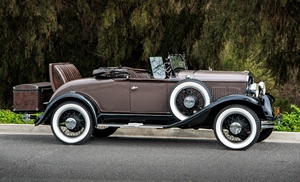|
By accessing or using The Crittenden Automotive Library™/CarsAndRacingStuff.com, you signify your agreement with the Terms of Use on our Legal Information page. Our Privacy Policy is also available there. |
Cars as Stars – How to get Movie and TV Work for Your Classic
In making The Dukes of Hazzard, Warner Bros
got through around 300 Dodge Chargers over the show’s 147-episode run. Now, if you happen to own a 1960s muscle car, you’d probably want to keep it a safe distance from a Dukes of Hazzard film set. But it gives an idea of just how much demand there is for period vehicles in the TV and movie industry.
Getting it right
The logistics of getting the right props on set at the right time is
critical to a movie’s success, and few props are more problematic for filmmakers than cars. If a lead actor is wearing a type of shoe that came out in 1975 in a movie set in 1970, it’s highly unlikely that anyone will notice.
But cars and trucks stand out. What’s more there are thousands of car nuts who will immediately spot any such anachronism as, for example, a
1947 Studebaker Starlight in a movie set during the Second World War. It's not just the cars that feature in the movie itself either – outdoor scenes need background vehicles, and they all have to be right.
A shot at fame
From this, it’s clear that if you have any sort of old car, from a priceless vintage racer from the 1920s to a battled-scarred 80s retro ride, it has the potential to become a TV or movie star – or at least the automotive equivalent of an extra with a walk on part.
The easiest way to make it happen is through a broker. Studios generally find it easier to work with brokers than individual car owners, and likewise, a good broker will ensure the car is only used on your terms. For example, at
Y’alleywood Film Cars, they have a significant inventory of their own vehicles, but also a network of private owners with cars of every type from every era.
Protecting your car
Thinking back on that Dukes of Hazzard example for a moment, you want to be sure your car will leave the set in the same condition it arrived there. It’s vital to have a contract drawn up so that both parties are clear on how the car will and will not be used.
In the majority of cases, your car will simply need to be parked on set like a background prop, or perhaps to drive by while the cameras are rolling. You can even stipulate that nobody gets to drive the car but you. Sure, it will rule your car out of any starring roles, but at least you’ll know it is in safe hands. And it’s even more fun pointing your car out on the TV or Netflix when you’re also visible behind the wheel!
A historical snapshot
And ultimately, fun is what it’s all about. Don’t expect to make a fortune – a studio might pay you $100 or so per day’s filming, which these days will cover your costs but little more. However, there’s definitely something special about seeing your classic transported back to its original time period. And after surviving all these years, it’s surely earned its 15 minutes of fame!

















 Antique DeSoto by Mark Dengan
Antique DeSoto by Mark Dengan
